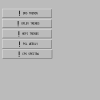|
Work Permit |
Date |
Description |
alog/status |
|
|
|
|
|
|
6326.html |
2016-11-15 09:09 |
Routine Pcal calibration measurements with Working Standard. |
|
|
6325.html |
2016-11-15 07:56 |
Transition LVEA to LASER SAFE for maintenance activities |
|
|
6324.html |
2016-11-14 15:34 |
Now that ER10 has started, the remote access to CDS (RACCESS) system needs to be active 24/7 for the duration of ER10 and O2. |
31513, 31517 |
|
6323.html |
2016-11-14 15:03 |
Remove temporary power supplies and connect to new 24V distribution. Items effected are: 1. Baffle Photodiode Amplifier Units (ITMX/ITMY) 2. BRS 3. RGA unit next to HAM4 BRS and beckhoff software will need to be restarted. |
31509 |
|
6322.html |
2016-11-14 11:21 |
The following activities are to prepare for an in-situ bake out of PT180 hardware which is to occur at a future, as yet undetermined, date - Position WEST Crane near BSC8 so as to use hook as a Safety Harness attachment point*Sit and or stand on BSC8 suspension cross beam to gain access to work area*Temporarily isolate PT180 from adjacent YBM Vacuum Volume via closing 1 1/2" isolation valve*Vent volume between closed pump port valve and NW40 blank*Remove 2.75"CFF-NW40 adapter and install small turbo pump in its place*Briefly run pump cart located on LVEA floor to pump turbo volume to rough vacuum then isolate turbo by closing the O-ring valve at its exhaust flange*Shut down pump cart*Open isolation valve and re-expose PT180 to YBM Vacuum Volume*Wrap PT180 hardware in aluminum foil and flexible electric heaters (a.k.a. "heat tapes"*Return West Crane to its nominal location |
31506 |
|
6321.html |
2016-11-14 11:19 |
Place last sensor on floor. |
31523 |
|
6320.html |
2016-11-14 10:48 |
Goal is to open all bypass exhaust valves on all cryopumps as a safety layer for pump overpressurization and to leave them open during normal operations. Today during my jog I will open those along x-arm and CP1 at Y-corner. The two at mid-Y (CP3,4) are already in an open state. The one remaining will be CP7. |
31512 |
|
6319.html |
2016-11-14 09:50 |
Set the control room default nds2 client to be the new 0.13.1 release with gap handling. This will affect python and matlab clients. Back out if there are problems |
31487 |
|
6318.html |
2016-11-14 09:23 |
Fix bug in h1susauxb123 monitor model -- rearranging channels for ITM LV ESD monitor that had mistakenly had double accounted for the unorthodox channel ordering. See LHO aLOG 30861. Should not require a DAQ restart. Model prep on Monday, installation on Tuesday. |
31493, 31517 |
|
6317.html |
2016-11-14 09:18 |
Turn off the DBB for the duration of ER10/O2. Since the DBB still uses 60Hz mains power, it is our standard procedure to turn it off during runs. |
|
|
6316.html |
2016-11-14 09:16 |
Re-center the ETMy optical lever. Also, take a look at the BS oplev. We had issues re-centering it last week, likely related to the pico-motor driver. The optics will have to be in their "Aligned" state for the duration. No viewports will be exposed during this work. |
31491 |
|
6315.html |
2016-11-14 09:07 |
Install the daqd fw build that is on h1fw2 onto h1fw0 & h1fw1. This will bring all the frame writers to a modern libframecpp (the same version that LLO is running) and get the updated leap second table in all the frame writers. |
h1fw0 upgraded 2016-11-15, 31517 |
|
6314.html |
2016-11-11 09:16 |
Reseat all cards and swap power supply in OAF IO chassis. This is to address issues with OAF computer crashing last few days. alog 31405 |
31478, 31490, & 31517 |
|
6313.html |
2016-11-10 08:17 |
Remove ADC card added with WP 6287 because h1oaf has become unstable since it's installation. Revert h1iopoaf0 model to previous version. Requires DAQ restart. Install removed card in DTS for further testing. |
31478 |
|
6312.html |
2016-11-09 14:28 |
Add new MD5 check sum channels to H1EDCU_DAQ.ini for frame writers. Requires DAQ restart. |
31517 |
|
6311.html |
2016-11-09 11:04 |
Install new fiber patch panels for communication links. Panels will be installed in MSR, Mid Stations, and End Stations. |
|





















